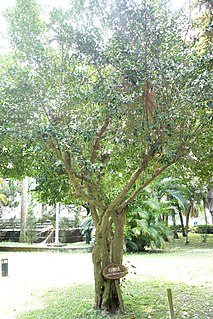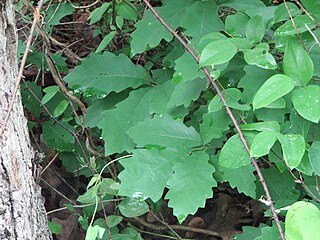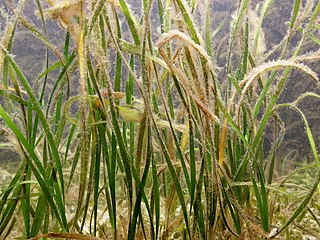
Quercus bicolor, the swamp white oak, is a North American species of medium-sized trees in the beech family. It is a common element of America's north central and northeastern mixed forests. It can survive in a variety of habitats. It forms hybrids with bur oak where they occur together in the wild.

Suregada is a plant genus of the family Euphorbiaceae, first described as a genus in 1803. It is native to tropical and subtropical regions of Africa, the Indian Subcontinent, China, Southeast Asia, Australia, and certain oceanic islands.

Johann Christoph Friedrich Klug, was a German entomologist. He described the butterflies and some other insects of Upper Egypt and Arabia in Christian Gottfried Ehrenberg and Wilhelm Friedrich Hemprich's Symbolæ Physicæ. He was professor of medicine and entomology in the University of Berlin where he curated the insect collections from 1810 to 1856. At the same time he directed the Botanic Garden in Berlin which contains his collections. Klug worked mainly on Hymenoptera and Coleoptera. The plant genus Klugia was named in his honour as well as the butterflies Geitoneura klugii and Heliophisma klugii.

Eduard von Martens also known as Carl or Karl Eduard von Martens, was a German zoologist.

Quercus prinoides, commonly known as dwarf chinkapin oak, dwarf chinquapin oak, dwarf chestnut oak or scrub chestnut oak, is a shrubby, clone-forming oak native to eastern and central North America, ranging from New Hampshire to the Carolinian forest zone of southern Ontario to eastern Nebraska, south to Georgia, Alabama, Louisiana, and Oklahoma. It has a virtually disjunct (discontinuous) distribution, fairly common in New England and in the Appalachian Mountains, and also in the eastern Great Plains but rare in the Ohio Valley in between.

Hysterionica is a genus of flowering plants in the daisy family.
Xanthocephalum is a genus of North American plants in the aster tribe within the sunflower family.

Lasiocephalus is a genus of South American flowering plants in groundsel tribe within the sunflower family. The genus was shown to be part of Senecio and predominantly occurs in tropical alpine-like regions.
Koelpinia is a genus of flowering plants in the dandelion family.

Gustav Tornier was a German zoologist and herpetologist.
Johan Peter Rottler was a French missionary and botanist, most associated with the Danish Mission in Tranquebar and later Vepery, Chennai in southern India.

Halodule wrightii is an aquatic plant in the Cymodoceaceae family. It is referred to by the common names shoalweed or shoal grass, and is a plant species native to seacoasts of some of the warmer oceans of the world. It has been reported from California, Texas, Florida, Louisiana, Mississippi, Alabama, North Carolina, Maryland, Yucatán, Quintana Roo, Tabasco, Costa Rica, Belize, Panamá, Cuba, Trinidad & Tobago, Venezuela, Brazil, Australia, Cape Verde, and Madagascar.
Karl Grünberg was a German entomologist specialising in Lepidoptera.
Zostera capricorni is a species of eelgrass in the Zosteraceae family. It is native to the seacoasts of New Guinea, Queensland, New South Wales, Victoria, South Australia, Norfolk Island and the North Island of New Zealand. It was first discovered at Moreton Bay in Queensland in 1875.
Zostera tasmanica is a species of marine eelgrass in the Zosteraceae family. It is native to the seacoasts of Tasmania, New South Wales, Victoria, South Australia, and Western Australia.

Najas gracillima, the slender waternymph, is a submerged species of aquatic plant in the Hydrocharitaceae family. found in lakes and streams. It is native to China, Russian Far East, Japan, Korea, Taiwan, Iran, Alberta, Ontario, Newfoundland, Nova Scotia, New Brunswick, the eastern United States. It is also considered introduced and naturalized in France, Spain, Italy and California.
Najas ancistrocarpa is a species of aquatic plant in the Hydrocharitaceae family. It grows in fresh water ponds and is a native to Japan (Honshu) and to parts of China.
Najas tenuifolia is an aquatic plant growing in fresh water ponds. It is a native to Hong Kong, Thailand, Indonesia, the Philippines and Australia.
Tetroncium is a genus of plants in the Juncaginaceae described as a genus in 1808. It contains only one known species, Tetroncium magellanicum, known from a few sub-Antarctic islands: Tierra Del Fuego, Falkland Islands, and Gough Island.The plant got the name magellanicum because the original description was describing the sample found near the Strait of Magellan.
Otto Wilhelm Hermann Reinhardt was a German botanist and conchologist. He was a teacher at a trade school in Berlin. Reinhardt was a friend of Paul Friedrich August Ascherson and co-founder of the botanical society in Brandenburg province.









